Circuit switching and packet - it's methods for solving the generalized problem of switching data in any network technology. Complex technical solutions of the generalized switching tasks in its entirety consists of the particular problems of data transmission networks.
By the special problems of data networks include:
- define flows and appropriate routes;
- fixation route configuration parameters, and tables of network devices;
- recognition flows and data transfer between one device interface;
- multiplexing / demultiplexing streams;
- separation medium.
Among the many possible approaches to the solution of the generalized problem of subscribers switching networks allocate two basic, which include channel switching and packet switching. Thus there are traditional applications of each switching techniques, for example, telephone networks continue to be built and constructed using circuit switched technology, computer networks and the vast majority are based on packet switching technique.
Therefore, as information flow in circuit-switched networks are the data exchanged between a pair of subscribers. Accordingly, the global flow feature is a pair of addresses (telephone numbers) subscribers communicate with each other. One feature of circuit-switched networks is the concept of an elementary channel.
Elementary channel
Elemental channel (or channel) - is a basic technical characteristics of the circuit switched network, which is fixed within a given type of network throughput value. Every link in the circuit switched network has a capacity of a multiple channel elementary adopted for this type of network.
In traditional telephone systems the value of the elementary channel speed is equal to 64 kbit / s, which is sufficient for high-quality digital voice.
For high-quality voice uses the frequency of sound vibrations amplitude quantization 8000 Hz (sampling time 125 ms intervals). To represent a measure of the amplitude is most often used 8-bit code, which makes 256 tone gradation (by sampling values).
In this case, the transmission of one voice channel is needed bandwidth 64 kbit / s:
8000 x 8 = 64000 bits / s or 64 kbit / s.
Such a voice channel is called an elementary channel digital telephone networks. A feature of the circuit switched network is that the bandwidth of each link must be equal to an integer number of elementary channels.
The composite channel
Communication constructed by switching (connection) of elementary channels, called a composite channel.
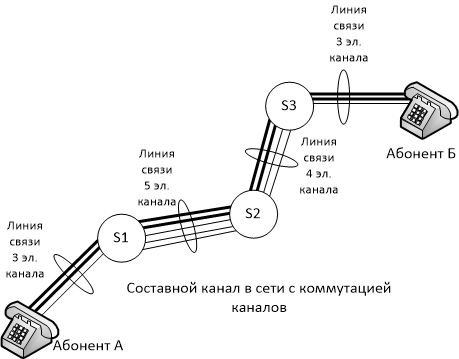
Составной канал The properties of the composite channel:
- composite channel throughout its length is made up of the same number of elementary channels;
- composite channel has a constant and fixed bandwidth throughout its length;
- composite channel is created temporarily for the period of the session two subscribers;
- at the session, all the basic channels that are included in the composite channel, enter the exclusive use of subscribers, for which the composite channel has been created;
- during the communication session in the subscribers can send network data rate not exceeding a channel capacity of the composite;
- data received in a composite channel, the called subscriber is guaranteed to be delivered without delay, losses, and at the same rate (source rate) regardless of whether there is at this time in the other network connection or not;
- after the end of the session the basic channels that were included with the corresponding composite channel, declared free and returned to the pool of resources allocated for use by other users.
Connection refused
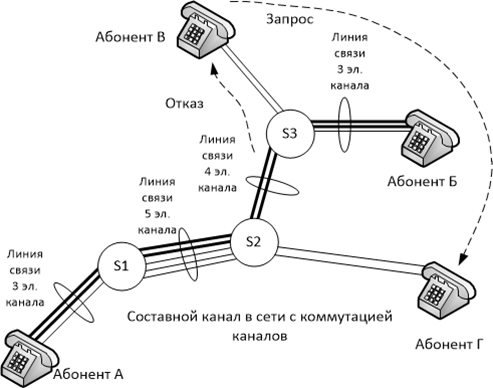
Connection refused Connection requests are not always successful.
If the path between the calling and called subscribers are no free channels or called basic node is busy, the malfunction occurs in the connection setup.
The advantage of circuit switching
Circuit switching technology is aimed at minimizing the accidental events in the network, ie a technology. In order to avoid any possible uncertainty much of the work on information exchange is carried out in advance, even before the start the data transfer. First, for a given address, the availability of the required basic channels all the way from the sender to the recipient. But in the case of bursty, this approach is inefficient, since 80% of the time channel may be idle.
Packet Switching
The most important principle of the networks with a packet switched data submission is transmitted over the network in the form of structurally separated from each other pieces of data called packets. Each packet has a header, which contains the destination address, and other supporting information (length of the data field, a checksum, and others.), Used for the delivery to the addressee of the package.
Having address in each packet is one of the most important features of packet switching technology, since each packet can be processed independently of the other switch packets constituting the network traffic. In addition to the title in the package may have one additional field to be placed at the end of the package and so-called trailer. In the trailer is usually placed checksum, which allows you to check whether the information has been corrupted during transmission over the network or not.
Partitioning the data into packets
Partitioning the data into packets takes place in several stages. Chain sender node generates transmission data, which is divided into equal parts. After that occurs the formation of a package by adding the header overhead. And the last stage is assembled packets into the original message to the destination node.
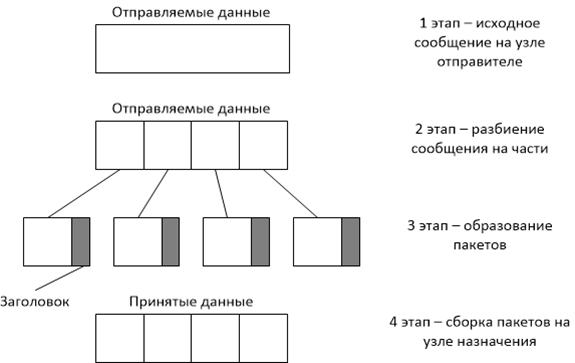
Partitioning the data into packets ### Transferring data over a network as a packet
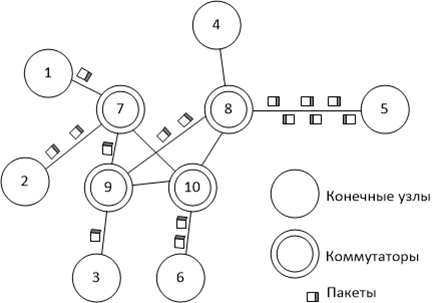
Packet Transmission Network As in the circuit switched networks, packet switched networks, for each of the streams is determined manually or automatically route fixed in the stored tables for commutation switches. Packets entering the switch are processed and sent on a particular route
Uncertainty and asynchronous movement of data in packet-switched networks makes special demands on the switches in such networks.
The main difference between a packet switch of the switches in the circuit-switched networks is that they have an internal buffer memory for temporarily storing packets. Switch buffers need to harmonize data rates in communication links connected to its interfaces, as well as to harmonize the rate of arrival packets with their switching speed.
Methods of transfer packages
A switch can operate on the basis of one of three methods promote packages:
- datagram transmission;
- Transfer to the establishment of a logical connection;
- Transfer to the establishment of a virtual channel.
Datagram transmission
Datagram transfer method based on the promotion of packet independent from each other. packet processing procedure is only determined by the values of parameters that it carries, and the current state of the network. And every single packet network is considered as a completely independent unit transfer - datagram.
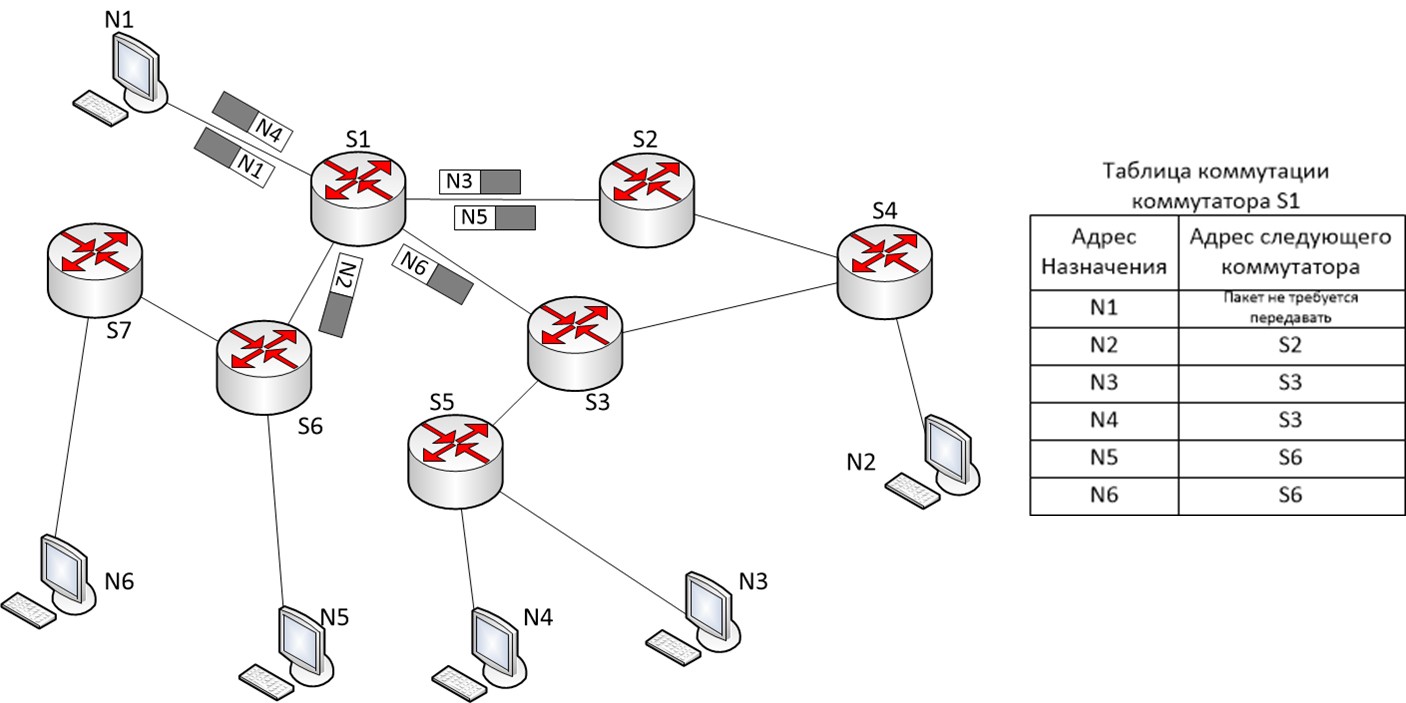
Illustration datagram packet principle ### Transfer to the establishment of a logical connection

Transfer to the establishment of a logical connection Procedure for harmonization of the two end nodes of a network of some parameters of packet exchange process is called the establishment of a logical connection. Options negotiated by the two interacting nodes, called a logical connection parameters.
Virtual channel
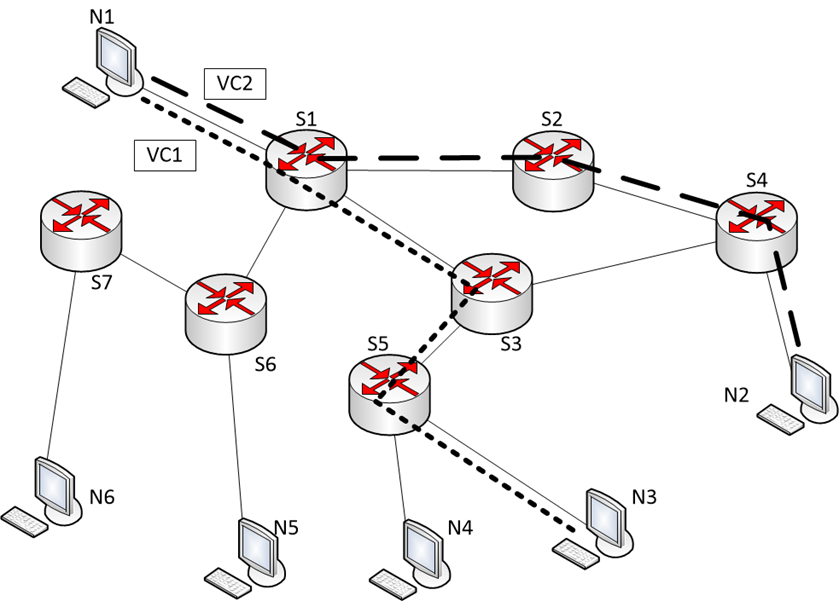
Virtual channel The only pre-padded fixed route connecting end nodes to the packet-switched network, referred to as a virtual channel (virtual circuit or virtual channel). Virtual channels are laid for sustainable information flow. In order to isolate the data flow of the total traffic flow of each packet is marked with a special kind of sign - label. As with the establishment of a logical network connections, the virtual channel begins with a gasket from the source node a special package - the connection request.
Table switching networks using virtual channels is different from the switching table in datagram networks. It contains entries only passing through the switch virtual channels, and not all the possible destination address, as is the case in networks with datagram algorithm transfer.
Comparison circuit-switched and packet
| Switching channels | Packet Switching |
|---|---|
| You must first establish a connection | No stage of establishing a connection (datagram method) |
| Location is only required when establishing a connection | Address and other service information are transmitted with each packet |
| The network may refuse a connection to the subscriber | The network is always ready to receive data from subscriber |
| Guaranteed bandwidth (bandwidth) for interacting subscribers | Network bandwidth for users is unknown, transmission delays are random |
| Real-time traffic is transferred without delay | Network resources are used effectively when transmitting bursty traffic |
| High transmission reliability | Possible data loss due to buffer overflow |
| Irrational use of channel capacity, reducing the overall efficiency of the network | Automatic dynamic bandwidth allocation of a physical channel between subscribers |
